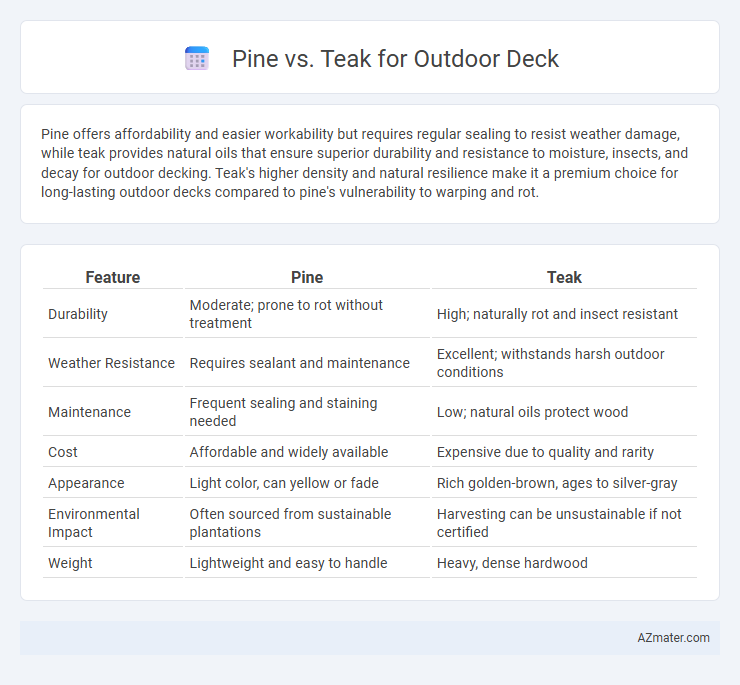Pine offers affordability and easier workability but requires regular sealing to resist weather damage, while teak provides natural oils that ensure superior durability and resistance to moisture, insects, and decay for outdoor decking. Teak's higher density and natural resilience make it a premium choice for long-lasting outdoor decks compared to pine's vulnerability to warping and rot.
Table of Comparison
| Feature | Pine | Teak |
|---|---|---|
| Durability | Moderate; prone to rot without treatment | High; naturally rot and insect resistant |
| Weather Resistance | Requires sealant and maintenance | Excellent; withstands harsh outdoor conditions |
| Maintenance | Frequent sealing and staining needed | Low; natural oils protect wood |
| Cost | Affordable and widely available | Expensive due to quality and rarity |
| Appearance | Light color, can yellow or fade | Rich golden-brown, ages to silver-gray |
| Environmental Impact | Often sourced from sustainable plantations | Harvesting can be unsustainable if not certified |
| Weight | Lightweight and easy to handle | Heavy, dense hardwood |
Introduction: Pine vs Teak for Outdoor Decks
Pine and teak represent two popular wood choices for outdoor decks, each offering distinct benefits in durability, appearance, and maintenance. Pine, a softwood, is widely accessible and affordable, but requires regular treatment to resist weathering and insect damage. Teak, a dense hardwood, naturally resists moisture, decay, and pests, making it a premium option for long-lasting, low-maintenance decks.
Visual Appeal: Color, Grain, and Aesthetics
Teak offers a rich golden-brown color with a distinctive, smooth grain that naturally enhances outdoor decks with warmth and elegance. Pine, by contrast, features a lighter, pale yellow hue with a more uniform, straight grain, providing a versatile and rustic look that can be easily stained or painted to match various design preferences. Teak's natural oils contribute to a luxurious, polished appearance that ages beautifully, while pine requires treatment to resist weathering and can develop a charming, weathered patina over time.
Weather Resistance and Durability
Teak wood stands out for outdoor decking due to its exceptional weather resistance and natural oils that prevent rot, insects, and moisture damage, delivering superior durability in harsh climates. Pine, while more affordable and easier to work with, requires pressure treatment and regular maintenance to withstand exposure to rain, sun, and temperature fluctuations, as untreated pine is prone to warping and decay. Choosing teak ensures long-term deck stability and minimal upkeep, whereas pine offers a budget-friendly option with increased maintenance efforts to achieve comparable durability.
Maintenance Requirements and Longevity
Pine outdoor decks require regular sealing and staining every 1-2 years to prevent moisture damage and maintain appearance, as pine is a softer wood prone to dents and decay. Teak offers superior longevity with natural oils that resist rot, pests, and weathering, minimizing the need for frequent maintenance and preserving structural integrity for 20-40 years. Choosing teak reduces long-term upkeep costs and extends deck lifespan, while pine demands consistent care to avoid premature deterioration.
Cost Comparison: Pine vs Teak
Pine is significantly more affordable than teak for outdoor decking, with prices typically ranging from $2 to $5 per square foot, compared to teak's $25 to $35 per square foot. While pine requires regular maintenance such as sealing and staining to prevent rot and weather damage, teak naturally resists decay and insect damage, reducing long-term upkeep costs. The initial budget-friendly cost of pine appeals to cost-conscious homeowners, but teak's durability and low maintenance can offer greater value over time despite the higher upfront investment.
Sustainability and Environmental Impact
Pine is a fast-growing softwood with a lower environmental footprint due to its rapid renewability and widespread availability in responsibly managed forests. Teak, known for its durability and natural resistance to decay, has a higher environmental impact as it often comes from slower-growing tropical trees, which can contribute to deforestation if not sourced sustainably. Choosing FSC-certified pine or teak ensures better sustainability practices and helps minimize the ecological impact of outdoor decking materials.
Installation Process and Ease of Use
Pine decking offers a straightforward installation process due to its lightweight nature and uniform grain, allowing for easy cutting and fastening with standard tools. Teak, while more dense and heavier, requires specialized tools and pre-drilling to prevent splitting, but its natural oils reduce the need for additional treatments during installation. Both materials benefit from experienced handling, but pine is generally favored by DIY enthusiasts for its ease of use and faster installation time.
Deck Comfort: Heat Retention and Texture
Pine decks tend to retain less heat than teak, making them cooler and more comfortable to walk on during hot weather. Teak's dense grain and natural oils result in a warmer surface but provide a smooth, luxurious texture that enhances comfort underfoot. Both woods offer durability, but teak's heat retention is balanced by its softness and natural resistance to splinters, improving overall deck comfort.
Common Applications for Pine and Teak Decking
Pine decking is commonly used for budget-friendly outdoor decks, picnic areas, and playsets due to its affordability, ease of staining, and moderate durability when pressure-treated. Teak decking is favored for high-end patios, pool surrounds, and yacht decks because of its exceptional natural resistance to water, rot, and insects, as well as its rich, golden color that improves with age. Both woods serve different market needs: pine suits economical, versatile projects while teak is preferred for luxury, long-lasting installations.
Final Verdict: Choosing the Best Wood for Your Deck
Teak offers superior durability, natural resistance to moisture, insects, and decay, making it ideal for long-lasting outdoor decks, while pine requires regular maintenance and treatment to withstand weathering. Pine, being more budget-friendly, suits homeowners who prefer frequent refinishing and shorter deck lifespan. For a low-maintenance, premium option with exceptional longevity, teak remains the best choice, whereas pine appeals to cost-conscious projects willing to invest in ongoing upkeep.

Infographic: Pine vs Teak for Outdoor Deck
 azmater.com
azmater.com